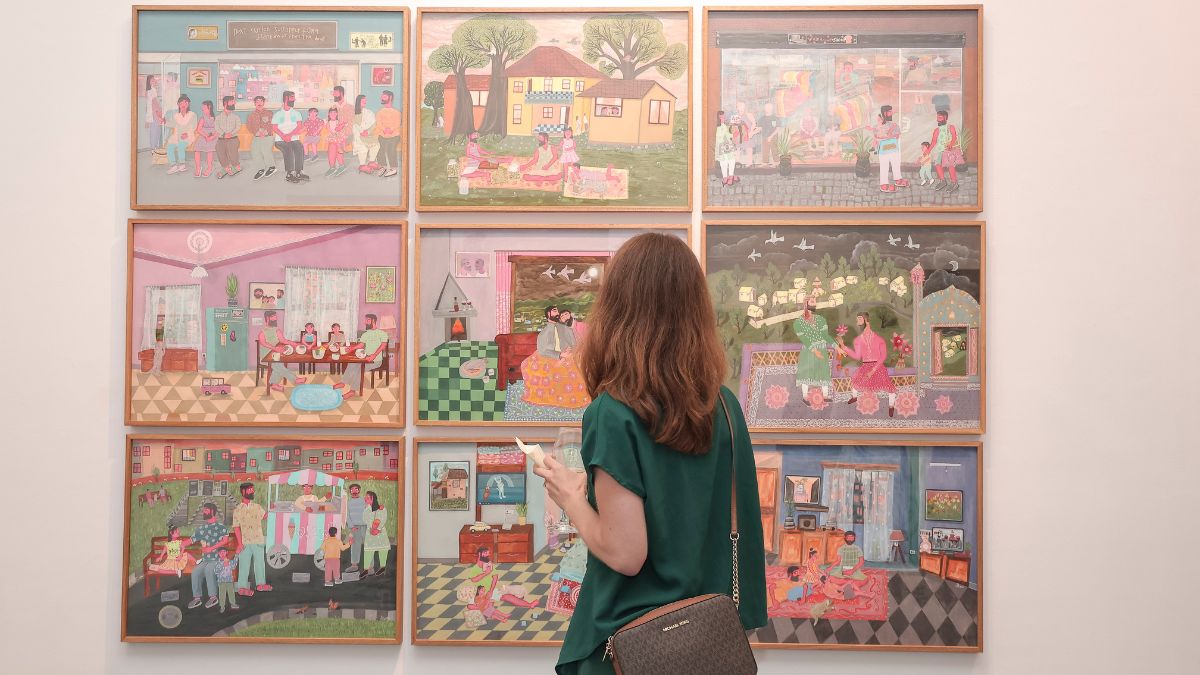Delhi Contemporary Art Week: The 'now' through artists’ lens

Danda Nach (punishment dance) is an all-male religious folk dance and theatrical ritual from Odisha’s Ganjam district.
“It’s a procession-style performance where only men from farming and labour families participate. They end up playing the female characters, too,” says Odisha-based artist B. Pradhan, whose artwork—an installation titled ‘Danda Nach’—is on display at Bikaner House, New Delhi for the Delhi Contemporary Art Week (August 31-September 4).
However, here, women are the actors, and what the artist showcases is their migration.
“Odisha had witnessed migration before, but by men. Now the women are migrating with their utensils and other household items,” the 29-year-old artist said.
Along with migration, several other contemporary themes—from love to war, and politics to leisure—are being showcased at the Delhi Contemporary Art Week (now in its 8th year) by the six women-led galleries: Latitude 28, Blueprint12, Gallery Espace, Shrine Empire, Exhibit 320, and the Vadehra Art Gallery.
“Every participating gallery focuses on different themes. Ours is on the artists who are marginalised,” says Mandira Lamba, co-founder of the contemporary art gallery Blueprint12.
Another striking work is a series of paintings that showcase queer love in public and private spaces. It makes the simple acts of eating at a dining table or lazing at a park profound, thus making a strong case for a more inclusive world.
Then there is Ketaki Sarpotdar’s ‘There is no need for a hundred bees to get a hundred flowers to bloom’ by Latitude 28, which showcases a family sitting in a circle, and playing Chinese whispers.
A newspaper lies at one corner, bearing the headline: “Saffron coloured building believed to be a temple in UP turns out to be a public toilet."
This is a metaphor for how misinformation travels, now more than ever through social media.
A series of paintings that blur the lines between past and present, East and West, high and mass entertainment is Pakistani artist Farhat Ali’s artworks, which reinterpret history and popular imagery through miniature painting.
Imagine miniature-style figurines co-existing with Mickey Mouse and Donald Duck, and that’s Ali’s paintings that also fuse two art forms—one tradition, the other rather contemporary—that remain widely popular in South Asia.
Leisure as an act of resistance
When it comes to women, artist Jayati Bose brings forth in her series of paintings that say yes.
She showcases women at leisure—faceless, barefoot, in muted tones—taking a break to mindfully do nothing.
“I’m a mother, and whenever I would take a break, the guilt trip would take a toll on me. And that’s the case with every woman. But why? Don’t we deserve it?” says Bose, who first started painting in 2021 “not to become an artist, but for leisure.”
On why she has kept the colours muted and forms faceless, she says that it was because "I didn’t want to build their identity, as it’s the story of every woman".
The highlight of the event is ‘Taqiya Kalam’, which reimagines art in living rooms, study rooms, and bathrooms, bringing forth an experience that is otherwise restricted to the white-walled, almost exclusive contours of the traditional idea of galleries.
Stepping into the exhibit—curated by Priyanshi S with Amrita Guha and Joya Nandurdikar of Untitled Design—is like entering into a collector’s home.
Here, you’ll find everything: from paintings and photographs to sculptures, books, pieces of furniture, and even charcuterie, thus also blurring the lines between different art forms.
There are no labels on the walls, and that’s "intentional", says curator Priyanshi S.
At one corner, the bathroom is reimagined as a place for queer intimacy, and on another, a pair of heels lies around, just like that.
Lines are blurred between the political and personal, the emotional and geopolitical, as themes and issues merge into one another at the Delhi Contemporary Art Week, which is on till September 4.
Lifestyle